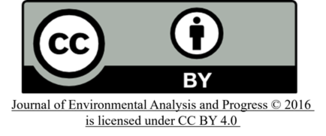Infestation of Crassostrea cf. brasiliana by boring-polychaete polydorids in estuaries from Northeastern Brazil
DOI:
https://doi.org/10.24221/jeap.2.1.2017.1005.16-22Keywords:
Benthos, Polychaeta, Mollusca, comensalismAbstract
The presence of polydorids shell-borer and the epifaunal polychaetes on Crassostrea cf. brasiliana were studied in five estuaries in Northeastern Brazil: The prevalence of shell-boring polychaetes in oysters varied significantly, showing dominance of Polydora websteri, with 57% of sampled oysters, and Boccardiella ligerica, with 11%, but the prevalence was significant different among estuaries sampled. Capibaribe River showed the highest infestation, with 81% these mud-blisters, but in Massangana River had no presence of these polychaetes. The linear regression between the number of polychaetes, and the size of oysters was significant, suggesting that infestation increases with age.Downloads
References
AMARAL, V.S.; SIMONE, L.R.L. 2014. Revision of genus Crassostrea (Bivalvia: Ostreidae) of Brazil. J. Mar. Biol. Assoc. UK., v.94, n.4, p. 811-836.
BLAKE, J.A. 1996. Family Spionidae Grube 1850. Including a review of the genera and species from California and a revision of the Genus Polydora Bosc, 1802. In: BLAKE, J. A.; HILBIG, B.; SCOTT,P.H. editors. Taxonomic atlas of the benthic fauna of the Santa Maria Basin and Western Santa Bárbara Channel. The Annelida part 3. Califórnia: Santa Bárbara Museum of Natural History, pp. 81–243.
BLAKE, J.A.; KUDENOV, J.D. 1978. The Spionidae (Polychaeta) from southeastern Australia and adjacent areas with revision of the genera. Mem. Nat. Mus. Vict., v. 39, p. 171–280.
BOSCOLO, R.; GIOVANARDI, O. 2002. Polydora ciliata shell infestation in Tapes philippinarum Manila clam held out of the substrate in the Adriatic Sea, Italy. J. Invertebr. Pathol., v. 79, p. 197–198.
BOWER, S.M.; MCGLADDERY, S.E.; PRICE, I.M. 1994. Synopsis of infectious diseases and parasites of commercially exploited shellfish. Annu. Rev. Fish Dis., v. 4, p. 1–199.
DÍAS, O.; LIÑERO-ARANA, I. 2009. Percentage of infestation level of Polydora cf. websteri Hartman, 1943 (Polychaeta: Spionidae) by size class of Crassostrea rhizhophorae (Guilding, 1828). Rev. científica 19(2): 113–118.
FEITOSA, F.A.N.; NASCIMENTO, F.C.R.; MUNIZ, K. 1999. Distribuição espacial e temporal da biomassa fitoplanctônica relacionada com parâmetros hidrológicos na Bacia do Pina (Recife-PE). Trab. Oceanogr. Univ. Fed. PE, v. 27, p. 1–13.
GHODE, G.S.; KRIPA, V. 2001. Polydora infestation on Crassostrea madrasensis : a study on the infestation rate and eradication methods. J. Mar. Biol. Assoc. India, v. 43, n. 1-2, p. 110 - 119
HANDLEY, S.J. 1995. Spionid polychaetes in Pacific oysters, Crassostrea gigas (Thunberg) from Admiralty Bay, Marlborough Sounds, New Zealand. New Zeal J Mar. Fresh, v. 29, p. 305–309.
HANDLEY, S.J.; BERGQUIST, P.R. 1997. Spionid polychaete infestations of intertidal pacific oysters Crassostrea gigas (Thunberg), Mahurangi Harbour, Northern New Zealand. Aquaculture, v.153, p. 191–205.
LESSER, M.P.; SHUMWAY, S.E.; CUCCI, T.; SMITH, J. 1992. Impact of fouling organisms on mussel rope culture: interspecific competition for food among suspension-feeding invertebrate. J Exp. Mar. Biol. Ecol., v. 165, p. 91–102.
LODEIROS, C.J.M.; HIMMELMAN, J.H. 2000. Identification of factors affecting growth and survival of the tropical scallop Euvola (Pecten) ziczac in the golfo de Cariaco, Venezuela. Aquaculture, v.182, p. 91–114.
LODEIROS, C.J.M.; GALINDO, L.; BUITRAGO, E.; HIMMELMAN, J.H. 2007. Effects of mass and position of artificial fouling added to the upper valve of the mangrove oyster Crassostrea cf. brasiliana on its growth and survival. Aquaculture, v. 262, p. 168–171.
MARTIN, D.; BRITAYEV, T.A. 1998. Symbiotic polychaetes: review of known species. Oceanogr. Mar. Biol., v.36, p. 217–340.
NEL, R.; COETZEE, P.S.; NIEKERK, G.V. 1996. The evaluation of two treatments to reduce mud worm (Polydora hoplura Claparède) infestation in commercially reared oysters (Crassostrea gigas Thunberg). Aquaculture, v.141, p. 31–39.
RADASHEVSKY, V.I. 2012. Spionidae (Annelida) from shallow waters around the British Islands: an identification guide for the NMBAQC Scheme with an overview of spionid morphology and biology. Zootaxa, v. 3152, p. 1–35
READ, G.B. 2010. Comparison and history of Polydora websteri and P. haswelli (Polychaeta: Spionidae) as mud-blister worms in New Zealand shellfisch. New zeal. J. Mar. Fresh., v.44, n. 2, p. 83–100.
ROYER, J.; ROPERT, M.; MATHIEU, M.; COSTIL, K. 2006. Presence of spionid worms and other epibionts in Pacific oysters (Crassostrea gigas) cultured in Normandy, France. Aquaculture, v. 253, p. 461–474.
SABRY, R.C.; MAGALHÃES, A.R.M. 2005. Parasitas em ostras de cultivo (Crassostrea rhizophorae e Crassostrea gigas) da Ponta do Sambaqui, Florianópolis, SC. Arq. Bras. Med. Vet. Zootec., v.57, n. 2, p. 194–203.
SALAZAR, J.C.; ROSAS, J.A.; RODRÍGUEZ, J.C. 2003. Condiciones sedimentológicas de la laguna la restinga, isla de margarita, Venezuela. Interciencia, v. 28, n. 1, p. 44–50.
SATO-OKOSHI W. 2000. Polydorid species (Polychaeta: Spionidae) in Japan, with descriptions of morphology, ecology and burrow structure. 2. Non-boring species. J. Mar. Biol. Assoc. UK, v.80, p. 443–456.
TAYLOR, J.J.; SOUTHGATE, P.C.; ROSE, R.A. 1997. Fouling animals and their effect on the growth of silver-lip pearl oysters, Pinctada maxima (Jameson) in suspended culture. Aqualculture, v. 153, p. 31–40.
VARGAS, L.; QUIJON, P.; BERTRAN, C. 2005. Polychaete infestation in cultured abalone (Haliotis rufescens Swainsosn) in Southern Chile. Aquac. Res., v. 36, p. 721–724.
WARGO, R.N.; FORD, S.E. 1993. The Effect of shell infestation by Polydora sp. and infection by Haplosporidium nelsoni (MSX) in the tissue condition of oysters, Crassostrea virginica. Estuaries, v. 16, p. 229–234.
WILLIAMS, J.D. 2000. A new species of Polydora (Polychaeta: Spionidae) from the Indo-West Pacific and first record of host hermit crab egg predation by a commensal polydorid worm. Zool. J. Linn. Soc-Lond., v, 129, p. 537–548
ZOTTOLI, R.A.; Carriker, M.R. 1974. Burrow morphology, tube formation, and microarchitecture of shell dissolution by the spionid polychaete Polydora websteri. Mar. Biol., v. 27, n. 4, p. 307–316.
Downloads
Published
How to Cite
Issue
Section
License
Material protegido por direitos autorais e plágio. No caso de material com direitos autorais ser reproduzido no manuscrito, a atribuição integral deve ser informada no texto; um documento comprobatório de autorização deve ser enviado para a Comissão Editorial como documento suplementar. É da responsabilidade dos autores, não do JEAP ou dos editores ou revisores, informar, no artigo, a autoria de textos, dados, figuras, imagens e/ou mapas publicados anteriormente em outro lugar. Se existir alguma suspeita sobre a originalidade do material, a Comissão Editorial pode verificar o manuscrito por plágio. Nos casos em que trechos já publicados em outro documento for confirmado, o manuscrito será devolvido sem revisão adicional e sem a possibilidade de nova submissão. Autoplágio (ou seja, o uso de frases idênticas de documentos publicados anteriormente pelo mesmo autor) também não é aceitável.
Direitos autorais: Autor
Material protected by copyright and plagiarism rights. In the case of copyrighted material being reproduced in a manuscript, full attribution should be informed in the text; an authorization document is proving to be sent to the Editorial Board as a supplementary document. It is the responsibility of the authors, not JEAP or editors or reviewers, to inform, in the article, the authors of texts, data, graphics, images and maps previously published elsewhere. If there is any suspicion about the originality of the material, the Editorial Board can check the manuscript for plagiarism. Where plagiarism is confirmed, the document will be returned without further review and the possibility of a new submission. Self-plagiarism (i.e., the use of the same phrases previously published documents by any of the authors) is not acceptable.
Copyright: Author






